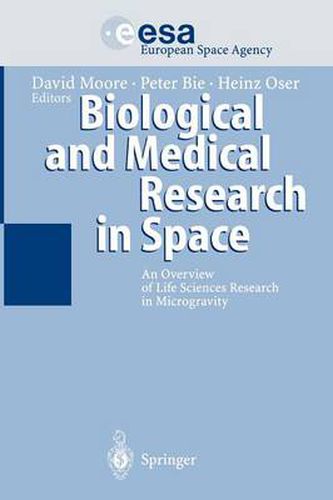Readings Newsletter
Become a Readings Member to make your shopping experience even easier.
Sign in or sign up for free!
You’re not far away from qualifying for FREE standard shipping within Australia
You’ve qualified for FREE standard shipping within Australia
The cart is loading…






This title is printed to order. This book may have been self-published. If so, we cannot guarantee the quality of the content. In the main most books will have gone through the editing process however some may not. We therefore suggest that you be aware of this before ordering this book. If in doubt check either the author or publisher’s details as we are unable to accept any returns unless they are faulty. Please contact us if you have any questions.
Life Science studies in space were initially driven by the need to explore how man could survive spaceflight conditions; the effects of being launched un der high accelerations, exposed to weightlessness and radiation for different periods of time, and returned to Earth in safety. In order to substantiate the detailed knowledge of potentially adverse effects, many model experiments were launched using organisms which ranged from bacteria, plants, inverte brates, rodents and primates through to man. Although no immediate life threatening effects were found, these experiments can be considered today as the precursors to life science research in space. Many unexplained effects on these life forms were attributed to the condition of weightlessness. Most of them were poorly recorded, poorly published, or left simply with anecdotal information. Only with the advent of Skylab, and later Spacelab, did the idea emerge, and indeed the infrastructure permit, weightlessness to be considered as an ex tended tool for research into some fundamental mechanisms or processes as sociated with the effect of gravity on organisms at all levels. The initial hy pothesis to extrapolate from hypergravity through 1 x g to near 0 x g effects could no longer be retained, since many of the experiment results were seen to contradict the models or theories in the current textbooks of biology and physiology. The past decade has been dedicated primarily to exploratory research.
$9.00 standard shipping within Australia
FREE standard shipping within Australia for orders over $100.00
Express & International shipping calculated at checkout
This title is printed to order. This book may have been self-published. If so, we cannot guarantee the quality of the content. In the main most books will have gone through the editing process however some may not. We therefore suggest that you be aware of this before ordering this book. If in doubt check either the author or publisher’s details as we are unable to accept any returns unless they are faulty. Please contact us if you have any questions.
Life Science studies in space were initially driven by the need to explore how man could survive spaceflight conditions; the effects of being launched un der high accelerations, exposed to weightlessness and radiation for different periods of time, and returned to Earth in safety. In order to substantiate the detailed knowledge of potentially adverse effects, many model experiments were launched using organisms which ranged from bacteria, plants, inverte brates, rodents and primates through to man. Although no immediate life threatening effects were found, these experiments can be considered today as the precursors to life science research in space. Many unexplained effects on these life forms were attributed to the condition of weightlessness. Most of them were poorly recorded, poorly published, or left simply with anecdotal information. Only with the advent of Skylab, and later Spacelab, did the idea emerge, and indeed the infrastructure permit, weightlessness to be considered as an ex tended tool for research into some fundamental mechanisms or processes as sociated with the effect of gravity on organisms at all levels. The initial hy pothesis to extrapolate from hypergravity through 1 x g to near 0 x g effects could no longer be retained, since many of the experiment results were seen to contradict the models or theories in the current textbooks of biology and physiology. The past decade has been dedicated primarily to exploratory research.